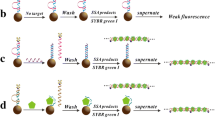Abstract
An electrochemical method for the detection of Epstein–Barr virus (EBV) infections is described. The method relies on an immunoassay with electrochemical read-outs based on recombinant antigens. The antigens are immobilised on an Au electrode surface and used to complementarily bind antibodies from serum samples found during different stages of infection with EBV. Thiol chemistry under formation of self-assembled monolayers functions as a means to immobilise the antigens at the Au electrodes. A reporter system consisting of a secondary antibody labelled with alkaline phosphatase is used for electrochemical detection. The feasibility of the assay design is demonstrated and the assay performance is tested against the current gold standard in EBV detection. Close correlation is obtained for the results found for the developed electrochemical immunoassay and a standard line assay. Moreover, the electrochemical immunoassay is combined with a nanoporous electrode system allowing signal amplification by means of redox recycling. An amplification factor of 24 could be achieved.

Amplified immunoassay for the determination of anti-EBV antibodies in serum based on enzyme amplification coupled with electrochemical amplification by redox cycling in nanopore electrodes





Similar content being viewed by others
References
Epstein MA, Achong BG, Barr YM (1964) Virus particles in cultured lymphoblasts from Burkitts lymphoma. Lancet 283:702–703
Marazza G, Chianella I, Mascini M (1999) Disposable DNA electrochemical sensor for hybridization detection. Biosens Bioelectron 14:43–51
Kutok JL, Wang F (2006) Spectrum of Epstein–Barr virus-associated diseases. Annu Rev Pathol - Mech Dis 1:375–404
Fleisher G, Bolognese R (1983) Persistent Epstein–Barr virus-infection and pregnancy. J Infect Dis 147:982–986
Henle W, Henle G (1981) Epstein–Barr virus-specific serology in immunologically compromised individuals. Cancer Res 41:4222–4225
Bauer G (2001) Simplicity through complexity: immunoblot with recombinant antigens as the new gold standard in Epstein–Barr virus serology. Clin Lab 47:223–230
Buisson M, Fleurent B, Mak M, Morand P, Chan L, Ng A, Guan M, Chin D, Seigneurin JM (1999) Novel immunoblot assay using four recombinant antigens for diagnosis of Epstein–Barr virus primary infection and reactivation. J Clin Microbiol 37:2709–2714
Gartner BC, Fischinger JM, Roemer K, Mak M, Fleurent B, Mueller-Lantzsch N (2001) Evaluation of a recombinant line blot for diagnosis of Epstein–Barr Virus compared with ELISA, using immunofluorescence as reference method. J Virol Meth 93:89–96
Dharuman V, Nebling E, Grunwald I, Albers J, Blohm L, Elsholz B, Worl R, Hintsche R (2006) DNA hybridization detection on electrical microarrays using coulostatic pulse technique. Biosens Bioelectron 22:744–751
Yudin AK, Siu T (2001) Combinatorial electrochemistry. Curr Opin Chem Biol 5:269–272
Erichsen T, Reiter S, Ryabova V, Bonsen EM, Schuhmann W, Markle W, Tittel C, Jung G, Speiser B (2005) Combinatorial microelectrochemistry: development and evaluation of an electrochemical robotic system. Rev Sci Instr 76:062204
Niwa O, Xu Y, Halsall HB, Heineman WR (1993) Small-volume voltammetric detection of 4-aminophenol with interdigitated array electrodes and its application to electrochemical enzyme-immunoassay. Anal Chem 65:1559–1563
Hintsche R, Paeschke M, Wollenberger U, Schnakenberg U, Wagner B, Lisec T (1994) Microelectrode arrays and application to biosensing devices. Biosens Bioelectron 9:697–705
Liepold P, Wieder H, Hillebrandt H, Friebel A, Hartwich G (2005) DNA-arrays with electrical detection: a label-free low cost technology for routine use in life sciences and diagnostics. Bioelectrochem 67:143–150
Neugebauer S, Muller U, Lohmuller T, Spatz JP, Stelzle M, Schuhmann W (2006) Characterization of nanopore electrode structures as basis for amplified electrochemical assays. Electroanalysis 18:1929–1936
Lohmuller T, Muller U, Breisch S, Nisch W, Rudorf R, Schuhmann W, Neugebauer W, Kaczor M, Linke S, Lechner S, Spatz JP, Stelzle M (2008) Nano-porous electrode systems by colloidal lithography for sensitive electrochemical detection: fabrication technology and properties. J Micromech Microeng 18:115011
Neugebauer S, Stoica L, Guschin D, Schuhmann W (2008) Redox-amplified biosensors based on selective modification of nanopore electrode structures with enzymes entrapped within electrodeposition paints. Microchim Acta 163:33–40
recomLine package insert, Mikrogen, available at http://www.mikrogen.de/english/deutschland/downloads.html (last visited February 28, 2010)
Morita M, Niwa O, Horiuchi T (1997) Interdigitated array microelectrodes as electrochemical sensors. Electrochim Acta 42:3177–3183
Acknowledgements
The authors are grateful to the German Ministry of Research and Education (BMBF) for funding within the framework of the project NanoBioPore (FKZ 13N8607). Dr. Martin Stelzle, Dr. Ulrich Müller, Prof. Dr. Joachim P. Spatz, Theobald Lohmüller, Dr. Stephan Linke, and Dr. Markus Kaczor are acknowledged for fabrication of nanopore electrode structures and helpful discussions.
Author information
Authors and Affiliations
Corresponding author
Additional information
This work was published in the special issue on Focus on Bioanalysis with Guest Editors Antje J. Baeumner, Günter Gauglitz and Frieder W. Scheller.
Rights and permissions
About this article
Cite this article
Bandilla, M., Zimdars, A., Neugebauer, S. et al. A microelectrochemical sensing system for the determination of Epstein–Barr virus antibodies. Anal Bioanal Chem 398, 2617–2623 (2010). https://doi.org/10.1007/s00216-010-3926-y
Received:
Revised:
Accepted:
Published:
Issue Date:
DOI: https://doi.org/10.1007/s00216-010-3926-y




